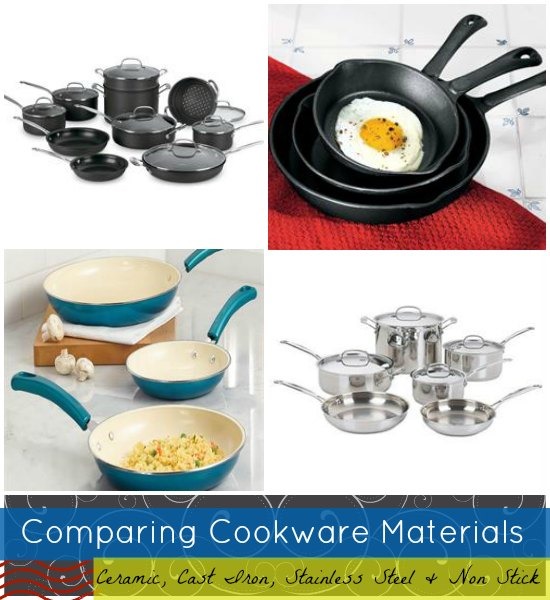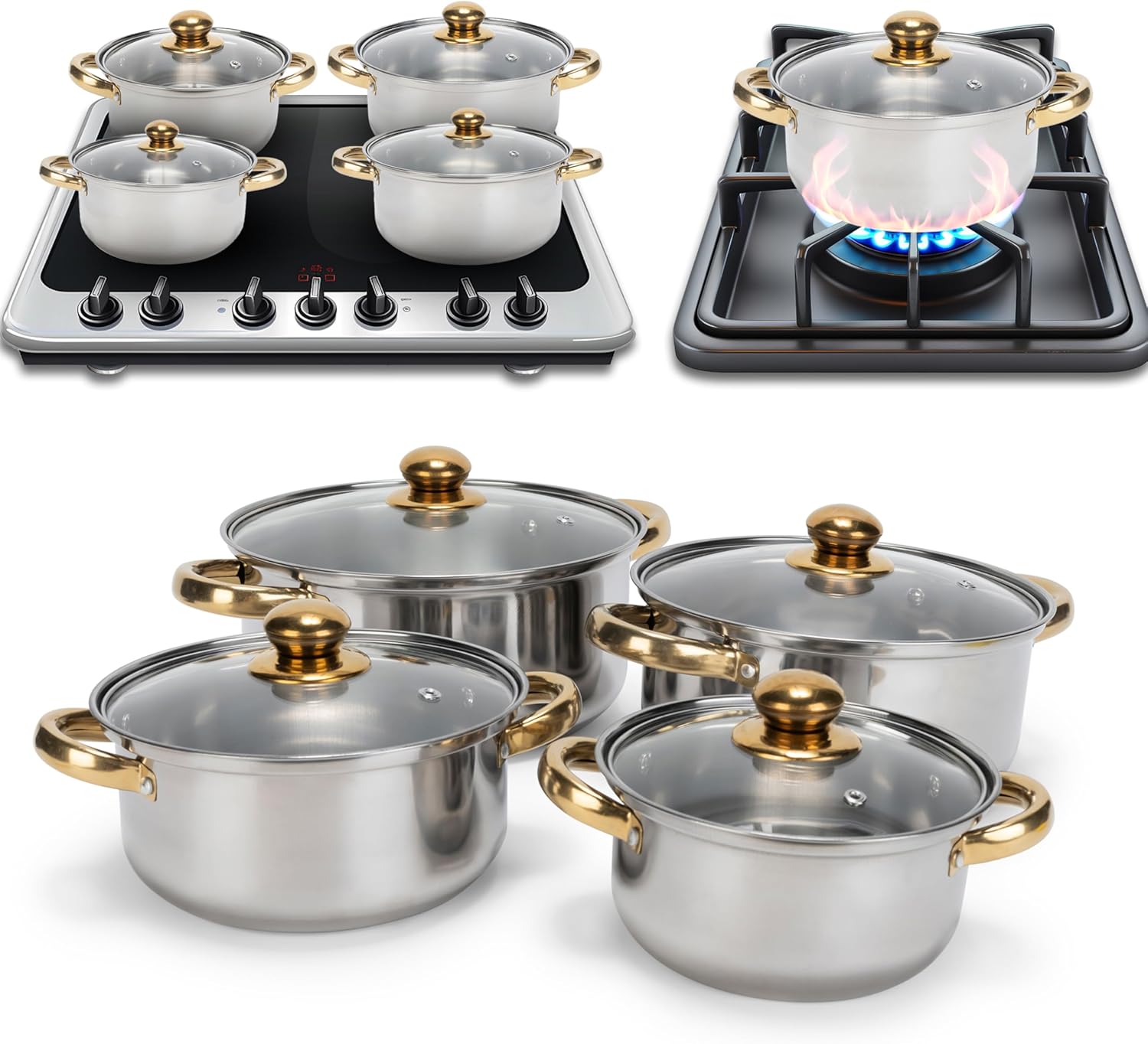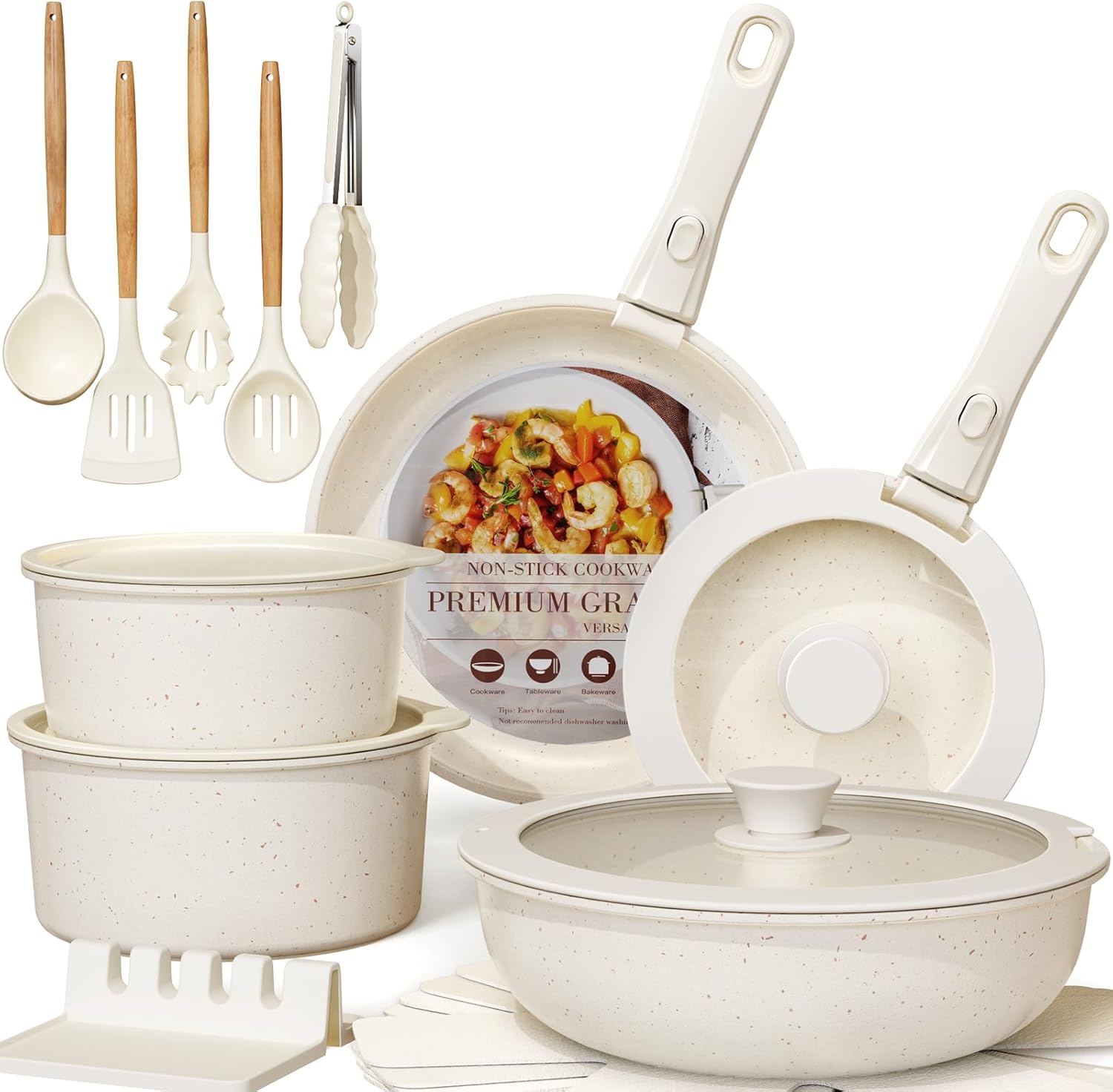Non-stick cookware offers easy food release and cleanup, while cast iron provides superior heat retention and durability. Each type has unique benefits depending on cooking style and preferences.
Non-Stick Vs Cast Iron Cookware Comparison:Choosing the right cookware can elevate your culinary experience. Non-stick cookware is favored for its convenience, making it ideal for everyday meals. It allows for easy flipping and reduces the need for excess oil. On the other hand, cast iron cookware is renowned for its ability to retain heat and develop a natural non-stick surface over time.
It excels in searing meats and baking. Understanding the strengths and weaknesses of each type helps you make an informed decision that suits your cooking needs. Explore the differences to find the perfect match for your kitchen adventures.
Introduction To Cookware Materials
Choosing the right cookware can change your cooking experience.
Different materials offer unique benefits.
Understanding non-stick and cast iron cookware helps you make the best choice.
Non-stick Essentials
Non-stick cookware makes cooking and cleaning easier.
It uses a special coating to prevent food from sticking.
This type of cookware is often lightweight and easy to handle.
- Easy Cleaning: Just wipe with a sponge.
- Less Oil Needed: Healthier cooking options.
- Quick Cooking: Heats up fast.
Non-stick pans are great for delicate foods.
Think pancakes, eggs, and fish.
However, they can scratch easily.
Avoid metal utensils to maintain the coating.
Cast Iron Basics
Cast iron cookware is known for its durability.
It retains heat well, making it perfect for searing.
This type of cookware can last a lifetime with proper care.
- Versatile: Use on the stove or in the oven.
- Natural Non-Stick: Develops a patina with use.
- High Heat Tolerance: Great for frying and baking.
Cast iron requires seasoning to maintain its surface.
It can be heavy, which may not suit everyone.
Regular maintenance is key to keeping it in top shape.

Credit: www.youtube.com
Historical Background
The history of cookware is rich and diverse. Non-stick and cast iron pans have unique origins. Understanding their evolution helps in choosing the right one for cooking. Here’s a look at the journey of both types of cookware.
Evolution Of Non-stick Pans
Non-stick cookware made a big splash in the kitchen. It began in the mid-20th century. Teflon, a brand name for polytetrafluoroethylene (PTFE), changed cooking forever.
- 1940s: Teflon was discovered by accident.
- 1960s: Non-stick pans became popular for home use.
- 1980s: More brands introduced their own non-stick products.
- 2000s: Eco-friendly non-stick options started emerging.
Non-stick pans make cooking easier. Food slides right off. Cleaning is simple and quick.
Cast Iron Through The Ages
Cast iron cookware has a long history. It dates back to ancient China. This material has been used for thousands of years.
- 500 BC: The first cast iron pots were created in China.
- 18th Century: Cast iron pans became popular in Europe.
- 19th Century: They were mass-produced in the United States.
- Modern Day: Cast iron is celebrated for its durability.
Cast iron cookware provides excellent heat retention. It can go from stovetop to oven. Proper care can make it last a lifetime.
| Cookware Type | First Use | Key Features |
|---|---|---|
| Non-Stick | 1940s | Easy to clean, food slides off |
| Cast Iron | 500 BC | Durable, excellent heat retention |
Material Properties
Understanding the material properties of cookware helps in making informed choices. Non-stick and cast iron each offer unique benefits. Let’s explore their compositions and how they affect cooking.
Non-stick Coating Science
Non-stick cookware features a special coating that reduces food sticking. This coating is usually made from polytetrafluoroethylene (PTFE), commonly known as Teflon. Here are some key properties:
- Easy to Clean: Food slides off easily.
- Low Fat Cooking: Requires less oil or butter.
- Lightweight: Easy to handle and maneuver.
- Heat Sensitivity: Can be damaged by high heat.
- Durability: Coating can wear off over time.
The non-stick surface is ideal for delicate foods. Eggs and pancakes cook perfectly without sticking. However, it’s important to use wooden or silicone utensils to protect the coating.
Cast Iron Composition
Cast iron cookware is made from iron and carbon. This material offers excellent heat retention and distribution. Key features include:
| Property | Benefit |
|---|---|
| Durability | Lasts for generations with proper care. |
| Versatility | Works on stovetops and in ovens. |
| Natural Non-Stick | Improves with seasoning over time. |
| Weight | Heavier than non-stick options. |
Cast iron pans require seasoning. This process creates a natural non-stick layer. They excel at high-temperature cooking, perfect for searing meats.
Both cookware types serve different needs. Choose based on cooking style and preference.
Heat Conductivity And Distribution
Understanding heat conductivity and distribution is vital in cookware selection. Different materials react uniquely to heat. This affects cooking efficiency and food quality. Let’s explore how non-stick and cast iron compare in this aspect.
Non-stick Heat Behavior
Non-stick cookware heats quickly. It often has a thin layer of aluminum or stainless steel. This allows for rapid heat conduction. Here are some key points about non-stick heat behavior:
- Even heat distribution across the surface.
- Preheats faster than cast iron.
- Best for low to medium heat cooking.
- Ideal for delicate foods like eggs and pancakes.
Non-stick surfaces prevent food from sticking. This makes cooking and cleaning easier. However, they can’t withstand high temperatures. Overheating can damage the non-stick coating.
Cast Iron Heating Characteristics
Cast iron cookware has unique heating properties. It is heavy and thick. This material retains heat well. Here are some essential features:
- Excellent heat retention.
- Distributes heat evenly, but takes longer to heat up.
- Ideal for searing, frying, and baking.
- Can be used on high heat without damage.
Cast iron excels in slow cooking. It maintains heat during long cooking periods. This results in perfectly cooked meals. The seasoning on cast iron enhances flavor and prevents sticking.
| Feature | Non-Stick Cookware | Cast Iron Cookware |
|---|---|---|
| Heat Up Time | Fast | Slow |
| Heat Retention | Poor | Excellent |
| Best Cooking Heat | Low to Medium | High |
| Food Types | Delicate foods | Meats, stews, baking |
Durability And Maintenance
Choosing between non-stick and cast iron cookware involves understanding their durability and maintenance. Each type has unique features affecting how long it lasts and how easy it is to care for.
Non-stick Lifespan
Non-stick cookware offers convenience but has a shorter lifespan. It typically lasts around 3 to 5 years. The non-stick coating can wear off over time. Scratches from metal utensils can damage it. Here are some key points:
- Non-stick coatings can degrade with high heat.
- Cleaning requires gentle sponges to avoid scratches.
- Do not use metal utensils for best results.
Replacing non-stick pans is common. They may become less effective over time. Regular checks help in assessing their condition.
Sustaining Cast Iron
Cast iron cookware is incredibly durable. It can last a lifetime with proper care. Here’s what makes it special:
| Feature | Details |
|---|---|
| Longevity | Can last for generations. |
| Maintenance | Requires seasoning to prevent rust. |
| Cleaning | Use hot water and a stiff brush. |
| Storage | Store in a dry place to avoid moisture. |
Seasoning helps maintain its non-stick surface. It enhances flavor and improves cooking performance. With care, cast iron can become a family heirloom.
Choose wisely based on your cooking style and maintenance preferences. Non-stick offers ease, while cast iron provides unmatched durability.

Credit: www.withourbest.com
Cooking Performance
Cooking performance is crucial when choosing cookware. It affects how food cooks, flavors develop, and meals are enjoyed. Let’s dive into the specifics of Non-Stick and Cast Iron cookware.
Non-stick Cooking Efficiency
Non-stick cookware shines in efficiency. It requires less oil and prevents food from sticking. This makes cooking and cleanup easier.
- Heat Distribution: Heats evenly, reducing hot spots.
- Temperature Control: Cooks food quickly at lower temperatures.
- Food Release: Food slides out easily, even delicate items.
Common non-stick materials include Teflon and ceramic. These materials enhance cooking performance by:
- Reducing smoke and odors.
- Making it easy to flip pancakes or eggs.
However, non-stick pans may scratch easily. Proper utensils and care are essential.
Cast Iron Culinary Results
Cast iron cookware offers excellent culinary results. It retains heat well, making it ideal for searing meats. It also develops a natural non-stick surface over time.
- Versatility: Suitable for stovetop and oven use.
- Flavor Development: Enhances taste through even cooking.
- Durability: Lasts for generations with proper care.
Cast iron requires more maintenance but rewards with superior results. Key benefits include:
| Feature | Non-Stick | Cast Iron |
|---|---|---|
| Heat Retention | Moderate | High |
| Ease of Cleaning | Easy | Moderate |
| Flavor Enhancement | No | Yes |
| Longevity | 5-10 years | Lifetime |
Both cookware types excel in different areas. Choose based on cooking style and preferences.
Health And Safety Considerations
Choosing the right cookware impacts health and safety. Non-stick and cast iron each have unique profiles. Understanding these can guide your cooking choices.
Non-stick Safety Profile
Non-stick cookware is popular for its ease of use. It requires less oil, making meals lighter. However, there are some safety concerns.
- Coating Material: Many non-stick pans use Teflon. If overheated, Teflon can release harmful fumes.
- Durability: Non-stick surfaces can scratch easily. A scratched surface may leach chemicals into food.
- Temperature Limit: Most non-stick pans are safe up to 500°F. Exceeding this can compromise safety.
Choose high-quality non-stick cookware to minimize risks. Look for brands that are PFOA-free.
Cast Iron Health Benefits
Cast iron cookware offers significant health benefits. It adds iron to your food, which is vital for health.
| Benefit | Description |
|---|---|
| Iron Supplementation | Cooking with cast iron can increase dietary iron intake. |
| Natural Non-Stick | Well-seasoned cast iron provides a natural non-stick surface. |
| Durability | Cast iron lasts for generations with proper care. |
Cast iron cookware withstands high temperatures. It’s safe for oven and stovetop use. Always season your pan to maintain its properties.

Credit: m.youtube.com
Cost And Affordability
Understanding the cost of cookware is crucial. Non-stick and cast iron options differ significantly. This section explores the affordability of each type.
Investing In Non-stick
Non-stick cookware is generally more affordable upfront. Prices can range from $20 to $200 depending on brand and quality.
- Basic models start around $20.
- High-end brands can reach $200 or more.
Consider these factors:
- Durability: Non-stick pans wear out over time.
- Replacement costs: Frequent replacements can add up.
- Maintenance: Special care may extend the lifespan.
Investing in quality non-stick cookware can save money in the long run. Look for brands that offer warranties for added peace of mind.
The Economy Of Cast Iron
Cast iron cookware has a higher initial cost. Prices can vary from $30 to $300.
| Quality Level | Price Range |
|---|---|
| Basic | $30 – $60 |
| Mid-Range | $60 – $150 |
| High-End | $150 – $300 |
Consider these benefits:
- Durability: Cast iron can last a lifetime.
- Versatility: Works well on all heat sources.
- Value: Better heat retention leads to cooking efficiency.
Though cast iron seems expensive, it is a wise investment. Many people pass it down through generations.
Environmental Impact
The choice between non-stick and cast iron cookware affects our planet. Each type has a different environmental footprint. Understanding these impacts helps you make an informed decision.
Non-stick Cookware Footprint
Non-stick cookware often contains chemicals like PTFE and PFOA. These substances can harm the environment during production and disposal.
- Production involves toxic chemicals.
- Non-stick coatings can degrade over time.
- Many non-stick pans end up in landfills.
Disposing of non-stick cookware contributes to pollution. The manufacturing process uses significant energy resources, increasing its carbon footprint.
Cast Iron Environmental Friendliness
Cast iron cookware is often considered more eco-friendly. It is durable and can last a lifetime with proper care.
- Made from natural materials.
- Highly recyclable at the end of its life.
- Minimal energy used in production.
Cast iron pans require less energy to maintain. They retain heat well, reducing cooking time and energy use.
| Feature | Non-Stick Cookware | Cast Iron Cookware |
|---|---|---|
| Material | Teflon, PFOA | Iron |
| Durability | 5-10 years | Lifetime |
| Recyclability | Poor | Excellent |
| Energy Use | High | Low |
Choosing cast iron cookware supports sustainability. It minimizes waste and reduces environmental harm.
Common Myths Debunked
Many people hold misconceptions about non-stick and cast iron cookware. These myths can lead to confusion. Let’s set the record straight.
Non-stick Misconceptions
Non-stick cookware is popular for its easy cleaning. Yet, some myths persist about its safety and durability.
- Myth 1: Non-stick pans are unsafe to use.
- Truth: Most non-stick cookware is safe. Brands use safe coatings.
- Myth 2: Non-stick surfaces can’t handle high heat.
- Truth: High heat can damage non-stick coatings. Always follow the manufacturer’s recommendations.
- Myth 3: Non-stick pans can’t be used with metal utensils.
- Truth: Some non-stick cookware is metal utensil safe. Always check the label.
Cast Iron Fallacies
Cast iron cookware has a long history. Yet, many myths surround its care and use.
- Myth 1: Cast iron pans are too heavy and hard to handle.
- Truth: While heavier, many people find them easy to use.
- Myth 2: Cast iron requires a lot of maintenance.
- Truth: Proper seasoning makes it easy to care for.
- Myth 3: Cast iron is not good for acidic foods.
- Truth: Well-seasoned cast iron handles acidic ingredients well.
Care And Cleaning Tips
Caring for your cookware ensures it lasts longer. Non-stick and cast iron require different methods. Proper cleaning keeps your food safe and tasty.
Maintaining Non-stick Surfaces
Non-stick cookware is popular for its easy cleanup. Follow these tips to maintain it:
- Use wooden or silicone utensils. Metal can scratch the surface.
- Wash by hand. Avoid the dishwasher to keep the coating intact.
- Use mild soap with a soft sponge. Harsh chemicals damage the surface.
- Avoid high heat. It can warp the pan and ruin the coating.
Store non-stick pans carefully. Stacking can cause scratches. Consider using pan protectors to keep surfaces safe.
Preserving Cast Iron
Cast iron cookware is durable and improves with age. Proper care is essential.
- Season your pan regularly. This keeps it non-stick and prevents rust.
- Wash with hot water. Use a brush or sponge, not soap.
- Dry immediately. Water can cause rusting.
- Apply a thin layer of oil after cleaning. This protects the surface.
Store cast iron in a dry place. Avoid stacking with other cookware to prevent scratches.
| Cookware Type | Care Tips |
|---|---|
| Non-Stick | Use silicone utensils, hand wash, avoid high heat |
| Cast Iron | Season regularly, wash with hot water, dry immediately |
Following these tips will keep your cookware in top shape. Enjoy cooking with both types safely and effectively.
The Verdict
Choosing between non-stick and cast iron cookware can be tough. Both options have unique benefits and drawbacks. Understanding these helps in making the best choice for your kitchen.
Choosing Between Non-stick And Cast Iron
Both non-stick and cast iron cookware serve different cooking needs. Here’s a quick comparison:
| Feature | Non-Stick Cookware | Cast Iron Cookware |
|---|---|---|
| Weight | Lightweight | Heavy |
| Heat Retention | Poor | Excellent |
| Durability | Less durable | Very durable |
| Maintenance | Easy to clean | Requires seasoning |
| Cooking Style | Ideal for low-fat cooking | Great for searing and frying |
Personal Preferences And Lifestyle
Your choice may depend on your cooking style and daily routine.
- Busy Lifestyle: Non-stick cookware saves time. It is easy to clean.
- Health-Conscious: Non-stick allows cooking with less oil.
- Culinary Enthusiasts: Cast iron offers unmatched flavor. It improves with age.
- Outdoor Cooking: Cast iron is perfect for campfires. It withstands high heat.
Consider how often you cook. Frequent cooks may prefer cast iron. Casual cooks may lean toward non-stick.
Think about your kitchen space too. Non-stick cookware is easier to store. Cast iron may take up more room.
Frequently Asked Questions
Which Is Better, Nonstick Or Cast Iron?
Nonstick cookware is easy to clean and ideal for low-fat cooking. Cast iron offers excellent heat retention and is durable. Choose nonstick for convenience and cast iron for versatility and seasoning benefits. Your preference depends on cooking style and maintenance willingness.
What Are The Disadvantages Of Cast Iron Pots?
Cast iron pots are heavy, making them difficult to handle. They require regular seasoning to prevent rust. Acidic foods can react negatively with the surface. Cleaning can be cumbersome, as they are not dishwasher safe. Lastly, they can be expensive compared to other cookware options.
Are Cast Iron Pans Better For Your Health?
Cast iron pans can enhance health by adding iron to your diet. They distribute heat evenly, which helps in cooking food thoroughly. Proper seasoning prevents sticking and reduces the need for excessive oils. Regular use can lead to better cooking practices and improved meal quality.
Why Is Cast Iron Cookware Better?
Cast iron cookware offers excellent heat retention and even cooking. It’s durable and can last a lifetime with proper care. The natural non-stick surface improves with seasoning, enhancing flavor in dishes. Versatile and safe for various cooking methods, it’s a favorite among chefs and home cooks alike.
Conclusion
Choosing between non-stick and cast iron cookware depends on your cooking style and preferences. Non-stick offers convenience and easy cleanup, while cast iron provides durability and superior heat retention. Both types have their unique benefits. Assess your needs carefully to make the best choice for your kitchen.
Happy cooking!




Leave a Reply